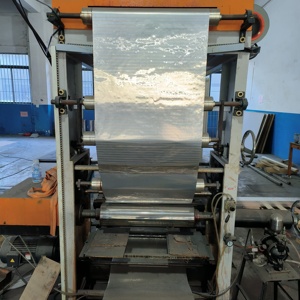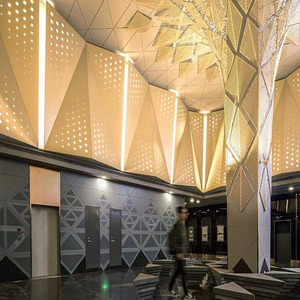(572 products available)

















































































































































































































Soffit cladding is the application of materials on the soffit to enhance its appearance and protect it from damage. Soffit cladding is used in different parts of buildings, such as eaves, overhangs, and ceilings. It comes in various types that can be adapted to meet different aesthetic needs and functional requirements. These include:
Vinyl Soffit Cladding
Vinyl soffit cladding is popular due to its affordability and low maintenance requirements. It comes in various colors and designs, allowing homeowners to choose options that fit their architectural designs. Vinyl soffit is designed to withstand harsh weather conditions without fading or becoming brittle. It is easy to install, requiring less time and effort.
Aluminium Soffit Cladding
This type of soffit cladding is lightweight and durable. It is popular in modern building designs and comes in various finishes, such as powder-coated and mill finish. Aluminum soffit cladding is resistant to rust and is preferred in coastal areas with high saline exposure. It requires minimal maintenance and provides adequate ventilation.
Timber Soffit Cladding
Timber soffit cladding is popular among homeowners who prefer natural materials. It is visually appealing and comes in different types, such as cedar, pine, and hardwood. Timber soffit cladding requires regular maintenance, such as sealing and painting, to protect it from moisture and UV rays. It provides adequate ventilation and insulation.
Fiber Cement Soffit Cladding
This type of soffit cladding is made from a mixture of cement, sand, and cellulose fibers. It is durable and weather-resistant and comes in various textures and colors. Fiber cement soffit cladding is resistant to pests, moisture, and fire and requires minimal maintenance. It is suitable for both coastal and humid regions.
PVC Soffit Cladding
PVC soffit cladding is durable and resistant to moisture, pests, and UV radiation. It is lightweight and comes in various colors and finishes. PVC soffit cladding does not require painting or sealing, making it a low-maintenance option. It is suitable for coastal and humid regions.
As mentioned, soffit cladding is installed on soffits. This is the underside of eaves or overhangs in a building. The cladding is fixed to rafters or directly to the roof.
The main purpose of soffit cladding is to cover and protect the underside of eaves. This helps in:
Different types of soffit cladding have various features, including:
Soffit cladding is an essential element in home construction. It is used in a wide range of applications, including:
Consider the following factors when choosing soffit cladding:
Climate
The climate of the region has a huge impact on the performance of soffit cladding materials. Vinyl or aluminum may be better options for homes in areas with high precipitation or coastal regions. These materials resist rust and are moisture-friendly. Wood may be a more suitable choice for soffits in warmer, drier climates, allowing for better aesthetic integration with the natural surroundings. Consider the local climate when selecting soffit materials to ensure longevity and optimal function.
Material
Each type of soffit cladding material has its advantages and disadvantages. Vinyl is popular due to its low maintenance and cost-effectiveness. Aluminum provides excellent durability and corrosion resistance, while wood offers aesthetic warmth but requires more maintenance. Consider factors such as budget, desired maintenance level, and climate when choosing the material. This ensures the chosen soffit meets functional requirements and complements the overall design.
Design
The design of the soffit cladding plays a crucial role in the overall appearance of the house. Consider the style of the home when choosing soffit designs, such as vented or unvented. Vented soffits are essential for roofs without ridge vents to allow airflow into the attic space. This prevents moisture buildup and promotes ventilation. Unvented soffits are suitable for roofs with adequate ventilation. They provide aesthetic continuity and may be solid or patterned.
Functionality
Soffit cladding serves important functions beyond aesthetics. Ensure the soffits chosen provide adequate ventilation for the roof and attic space. This prevents issues like mold growth, moisture buildup, and structural damage. Proper ventilation regulates temperatures, especially during hot or humid weather. It reduces the risk of condensation and extends the lifespan of roofing materials. Consider the functional benefits of soffit cladding in addition to its visual appeal.
Q: What are the benefits of soffit cladding?
A: Soffit cladding helps homeowners by reducing maintenance costs, providing long-lasting appearance and protection, and improving ventilation.
Q: What materials are used for soffit cladding?
A: Commonly used materials for soffit cladding include PVC, aluminum, and timber.
Q: What are the disadvantages of soffit cladding?
A: Some disadvantages include limited design options, potential for condensation, and difficulty in repairs.
Q: What is the purpose of a soffit?
A: The soffit is an important part of a house. It provides ventilation to the roof space, preventing overheating and removing moisture. It also protects the underside of the eaves from debris and animals. Furthermore, it is important for the structural integrity of a roof and prevents damage.
Q: What is the difference between fascia and soffit?
A: The fascia is the board that runs along the roofline where the roof meets the exterior of the house. It is exposed and visible. The soffit is located underneath the eaves and covers the underside of the overhang. It is also exposed and visible. The fascia and soffit are important for ventilation, providing a finished appearance, and protecting the roof's structural components.